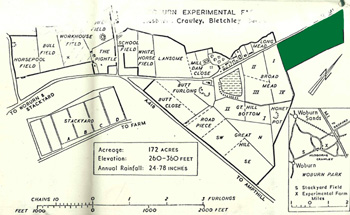Warren Field Husborne Crawley

Warren Field shown in green
In 1970 Bedfordshire and Luton Archives and Records Service staff carried out research on a number of fields belonging to Woburn Experimental Farm in Husborne Crawley. This seems to have been prompted by an enquiry from The Ministry of Agriculture, Fisheries and Food Plant Pathology Laboratory about Workhouse Field.
Research on Warren Field [CRT130HusborneCrawley2] revealed that in 1760 [R1/42] the ground was occupied by twelve strips of Broad Mead Upper Shot, part of seven strips of Broad Mead Nether Shot, part of four strips of Long Army Moore and all seven strips of Short Army Moore. This was Midsummer land - in other words permanent pasture preserved either for hay or for tethering beasts owned by people with the necessary rights until Midsummer Day when the pasture became common.
When Husborne Crawley was inclosed in 1799 [MA75] the land formed part of the seventh allotment to the Duke of Bedford and by 1820 [R1/43] had been amalgamated with other land to form Broad Mead. In 1866 [R4/209] the land formed part of , Ridgmont and totalled 25 acres, 1 rood, 10 poles.
Cropping books forming part of the estate archive of the Duke of Bedford [R4/209, 215, 223 and 229] show cropping as follows:
- 1866: fallow;
- 1867: barley;
- 1868: beans;
- 1869: wheat;
- 1870: fallow;
- 1871: barley;
- 1872: clover and beans in the ratio 20:5;
- 1873: wheat;
- 1874: fallow;
- 1875: wheat and fallow in the ratio 14:11;
- 1876: not recorded;
- 1877: half wheat and half clover;
- 1878: half fallow and half wheat;
- 1879: wheat and fallow in the ratio 14:11.
The field was then divided and fourteen acres were leased to the Royal Agricultural Society. Cropping for these fourteen acres was still noted, however, and was as follows:
- 1880: roots;
- 1881-1882: experimental uses;
- 1883: experimental clover and pats in the ratio 5:9;
- 1884: oats, fallow and experimental uses;
- 1885: beans and barley;
- 1886: experimental uses and oats in the ratio 9:5;
- 1887: roots;
- 1888: experimental planting of oats and wheat in the ratio 7:7;
- 1889: wheat;
- 1890: roots;
- 1891: roots; 1891: oats and barley in the ratio 10:4;
- 1892: clover;
- 1893: wheat;
- 1894: roots and oats in the ratio 2:12;
- 1895: manure, wheat and oats in the ratio 2:3:9;
- 1896: roots and potatoes in the ratio 12;3;
- 1897: oats;
- 1898: potatoes, manure, beans and oats in the ratio 3:4:4:3;
- 1899: oats and wheat in the ratio 4:10;
- 1900: roots and oats in the ratio 7:7;
- 1901: oats and wheat in the ratio 7:7;
- 1902: oats and roots in the ratio 5:9;
- 1903: clover and oats in the ratio 5:9;
- 1904: wheat and roots in the ratio 7:7;
- 1905: oats;
- 1906: roots, oats and fallow in the ratio 7:3:4;
- 1907: wheat;
- 1908: roots and oats in the ratio 4:10;
- 1909: wheat, potatoes and fallow in the ratio 5:6:3.